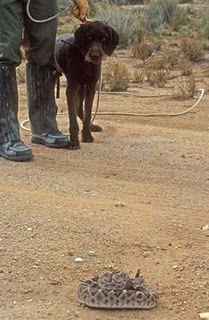Why You Should Snake-Train Your Dogs
Share

 In the Southwest, Spring has officially sprung. With temperatures soaring into the 90s this month, we are already seeing Game and Fish departments issue warnings that rattlesnakes are making an early appearance. This makes it more important than ever that you get your dog snake-trained.
In the Southwest, Spring has officially sprung. With temperatures soaring into the 90s this month, we are already seeing Game and Fish departments issue warnings that rattlesnakes are making an early appearance. This makes it more important than ever that you get your dog snake-trained.
Whether you call it rattlesnake training, snake proofing or rattlesnake avoidance – the training, while appearing rather brutal, is a necessary step in protecting your pets. It could be the thing that saves your pet’s life, your child’s life, or your own life.
[heading style=”1″ color=”#996633″ style_color=”#996633″]Why you should snake-train your dog[/heading]Most bites occur when a snake, in search of a meal or warm place to sleep, is discovered by a curious pet. While we are far more dangerous to a snake than they are to us, it’s still important to avoid them. Dogs need to be trained to do this or they may mistake a diamondback for a chew toy.
The costs of treating your dog for a snake bite can range from $1,000 to $6,000 depending on the severity of bite, amount of toxin released, and reaction time of the owner. Many dogs don’t even make the trip to the veterinarian. I don’t want to scare you – but I do want you to understand how important this process is to protect your pet.
 Even if you always keep your pet on a leash while out on trail, a simple misstep can result in a dog being bitten. Western Diamondback rattlesnakes can “jump” (okay, “reach”) about 1/3 – 1/2 of their body length. For those of you who have never seen a healthy rattler, that’s about 4-5 feet with a reach of about 3 feet.
Even if you always keep your pet on a leash while out on trail, a simple misstep can result in a dog being bitten. Western Diamondback rattlesnakes can “jump” (okay, “reach”) about 1/3 – 1/2 of their body length. For those of you who have never seen a healthy rattler, that’s about 4-5 feet with a reach of about 3 feet.
The deep puncture wounds they inflict can cause severe, often crippling and deadly, damage to its victim.Your pet’s survival is a result of how fast you can get them to the veterinarian and where the bite occurs.
Many snake bites are “dry” bites, which means that the snake is not injecting poison. They don’t want to waste their venom on a victim they can’t eat. However, if your pet is one of the unlucky ones to receive a dose of venom, the effects are immediate and include:
- Severe swelling, often resulting in asphyxiation
- Respiratory depression and/or cardiac arrest
- Paralysis, shock, loss of consciousness
- Severe pain
[heading style=”1″ color=”#996633″ style_color=”#996633″]How Snake Training Works[/heading]
There are many ways to train a dog to avoid snakes, but aversion therapy is the most successful. Yes, it uses static charge collars. Yes, it’s difficult to watch. Yes, you MUST have a trainer you trust handle the training. BUT – it could save your dog’s life in the long run. The good thing is that it (in most cases), the training only needs to be done once. You should allow the trainer to handle your dog during this training. If you don’t, you could unintentionally “cue” your pet, which defeats the purpose. While you can be present for the training, you should not be involved.
A good trainer will teach dogs to avoid snakes using sight, sound and smell. Ensure that the trainer you use has a long line of references and positive feedback from previous clients. They will lead your dog through a “rattlesnake” course, utilizing sight, sound and smell to allow the dog to identify a snake.
Depending on the dogs reaction, there are several events that can occur. These depend on the training methods used. Snake aversion therapy is one of the few training events I would ever use a collar for, because it’s that important for the dog to associate a strong reaction with seeing or hearing or smelling a snake.
The snakes are most often ones that have been removed from the backyards of terrified homeowners. The snakes should later be released into the wild – ensure you find a humane trainer who handles the snakes humanely.
[heading style=”1″ color=”#996633″ style_color=”#996633″]What to look for in a trainer[/heading]
When taking your dog in for “snake aversion” therapy, check your local listings for a qualified, accomplished, and highly trained facility who offers humane methods of training. Ensure that they treat the “volunteer snakes” well, ask for references, check the online sites and ask around. This is too important not to do your homework.
- There are many ways to snake proof your dog. Look for a training facility that has a long history of snake-proofing.
- The trainer should teach the dog to run away from the snake, not to freeze, point or attack.
- The trainer should utilize sight, sound and smell to train the dog.
- The trainer should get it right the first time as the training can be very stressful.
- The trainer should use live snakes. There is some debate about whether they should use dead snakes, crated snakes, defanged snakes, or rubber snakes. I’m not going to take sides on that. (I will say, “If you’re walking along a trail or in the backyard, your dog will not be running across a crated snake.”) Just use your head and make sure the trainer is using their head…
[heading style=”1″ color=”#996633″ style_color=”#996633″]How Long Does the Training Last?[/heading]
That depends on the type of training, the effectiveness of the trainer, the dog, the owner, and a whole slew of other factors. The recommendation is that you do a refresher course each year. Only you know your dog. The majority of snake trained dogs that I’ve seen have alerted for years without refresher courses or ever running into a snake. So, do what you think is right.
[box title=”Resources” box_color=”#996633″ radius=”13″]ASPCA Poison Control Hotline
1-888-426-4435
Note: There is a $60 charge for this service.
The National Animal Poison Control Center (NAPPC)
1-800-548-2423
1-900-680-0000
Note: If you call the 1-900 number, the charge is $20.00 for the first five minutes, then $2.95/minute thereafter. If you use the 800 number, the charge is $30.00 per case.








